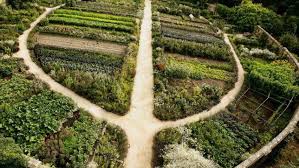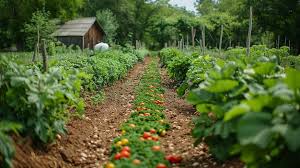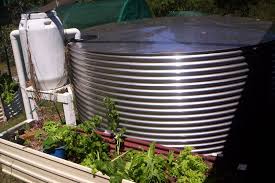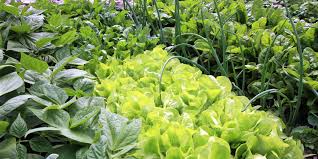Permaculture cropping systems are innovative agricultural practices designed to create sustainable and self-sufficient food production systems.
Rooted in the principles of permaculture, these systems emphasize the harmonious integration of plants, animals, and the environment to maximize biodiversity and minimize waste.
By mimicking natural ecosystems, permaculture cropping systems focus on building healthy soils, conserving water, and promoting resilience against pests and diseases.
This approach not only aims to meet the needs of current generations but also ensures that future generations can benefit from the land’s resources.
At the heart of permaculture is the concept of working with nature rather than against it. Traditional farming methods often rely heavily on synthetic fertilizers and pesticides, leading to soil degradation, water pollution, and loss of biodiversity.
In contrast, permaculture cropping systems employ techniques that enhance soil fertility and promote ecological balance. These methods include the use of cover crops, crop rotation, and polyculture, which involve planting a diverse range of species together.
Such practices not only improve soil health but also create a more resilient agricultural system that can withstand the challenges posed by climate change and environmental degradation.
One of the key principles of permaculture cropping systems is the focus on soil health. Healthy soil is the foundation of sustainable food production, as it provides essential nutrients, supports plant growth, and aids in water retention. Techniques such as composting, mulching, and minimal tillage are commonly used to improve soil structure and fertility.
By fostering a thriving soil ecosystem, farmers can reduce their reliance on chemical inputs, leading to healthier crops and a more sustainable farming practice.
Water conservation is another crucial aspect of permaculture cropping systems. With increasing pressures from climate change and population growth, efficient water management is essential for sustainable agriculture.
Permaculture practices encourage the use of rainwater harvesting, swales, and contour farming to enhance water retention in the landscape.
By designing farms that capture and store water, farmers can create more resilient cropping systems that thrive even in times of drought.
Biodiversity plays a significant role in permaculture cropping systems, as it contributes to ecosystem stability and resilience. Diverse plant and animal species can support each other in a mutually beneficial manner, reducing the need for synthetic inputs and enhancing pest control.
For example, planting flowers alongside vegetable crops can attract beneficial insects that pollinate plants and help manage pest populations. By fostering a rich variety of species, permaculture cropping systems create an interconnected web of life that supports sustainable food production.
In addition to environmental benefits, permaculture cropping systems also promote social and economic sustainability. By prioritizing local food production, these systems can strengthen community resilience and reduce reliance on industrial food systems.
Farmers practicing permaculture can connect with local markets, promoting food sovereignty and encouraging healthier eating habits within their communities.
Permaculture cropping systems represent a transformative approach to food production that prioritizes sustainability, biodiversity, and community well-being. By integrating ecological principles into agricultural practices, these systems offer a viable solution to the challenges facing modern agriculture.
Principles of Permaculture Design

1. Observe and Interact: Taking time to observe natural systems and interactions helps create designs that work harmoniously with the environment.
2. Catch and Store Energy: Utilizing natural resources effectively, such as rainwater harvesting and solar energy, enhances sustainability and reduces reliance on external inputs.
3. Obtain a Yield: Designing systems that produce food, materials, or energy ensures that the design is productive and meets the needs of the users.
4. Apply Self-Regulation and Accept Feedback: Incorporating feedback loops allows for continuous improvement and adaptation of the design to changing conditions.
5. Use and Value Renewable Resources: Prioritizing the use of renewable resources, such as compost and rainwater, minimizes waste and enhances sustainability.
6. Produce No Waste: Designing systems that recycle waste products back into the system, such as composting and reusing materials, reduces environmental impact.
7. Design from Patterns to Details: Starting with broad patterns, such as landscape features, before focusing on specific elements helps create a cohesive design.
8. Integrate Rather Than Segregate: Creating connections between different elements in the system promotes synergy and resilience, enhancing overall productivity.
9. Use Small and Slow Solutions: Implementing small-scale, manageable solutions allows for more control and adaptability, making it easier to maintain and adjust the system.
10. Use and Value Diversity: Promoting biodiversity within the system increases resilience, productivity, and ecosystem health, allowing for more robust food production.
11. Use Edges and Value the Marginal: Maximizing the potential of edge spaces, such as garden borders or ponds, enhances productivity and biodiversity.
12. Creatively Use and Respond to Change: Adapting designs in response to changing conditions and challenges fosters resilience and sustainability.
Benefits of Permaculture in Food Production
1. Increased Biodiversity: Permaculture promotes diverse plant and animal species, enhancing ecosystem stability and resilience while improving pest and disease management.
2. Improved Soil Health: Techniques such as mulching, cover cropping, and composting enhance soil fertility, structure, and moisture retention, leading to better crop yields.
3. Efficient Resource Use: By designing systems that maximize resource efficiency, such as water and nutrients, permaculture reduces waste and lowers input costs.
4. Sustainable Food Systems: Permaculture creates self-sustaining systems that can produce food over the long term without depleting natural resources or harming the environment.
5. Resilience to Climate Change: Diverse and integrated systems can better withstand climate variability and extreme weather, ensuring consistent food production.
6. Community Empowerment: Permaculture encourages local food production, reducing dependency on external food sources and fostering community resilience and food sovereignty.
Read Also: Pests of Stored Products and Damages Caused
Key Components of Permaculture Systems

1. Zones: Organizing elements based on their needs and interactions, with more intensive and frequently visited areas (like vegetable gardens) located closer to the home.
2. Sectors: Analyzing external environmental factors, such as wind, sun, and water flow, helps position elements to optimize their benefits and minimize challenges.
3. Guilds: Creating plant and animal communities that support each other through complementary functions, enhancing overall productivity and resilience.
4. Water Management: Implementing techniques such as swales, ponds, and rain gardens to capture and manage water efficiently within the landscape.
5. Soil Building: Using organic matter, cover crops, and natural amendments to improve soil fertility and health, promoting robust plant growth.
Designing a Permaculture Garden
1. Analyze Your Site: Evaluate the site’s sun exposure, wind patterns, water flow, and existing vegetation to understand the unique conditions of your garden space.
2. Create a Design Plan: Use permaculture principles to sketch a layout that includes zones (intensive areas closer to the house and less intensive areas farther away) and sectors (considering external environmental factors).
3. Establish Zones: Organize your garden into zones based on plant needs, access, and maintenance frequency, placing the most labor-intensive plants closest to your home for easy care.
4. Plan for Diversity: Incorporate a variety of plants, including vegetables, fruits, herbs, and flowers, to enhance biodiversity, support beneficial insects, and create a resilient ecosystem.
5. Implement Companion Planting: Choose plants that support each other’s growth, such as pairing tomatoes with basil or carrots with onions, to naturally repel pests and enhance growth.
6. Include Perennials: Focus on incorporating perennial plants that will produce yields year after year, reducing the need for replanting and promoting soil health.
7. Use Vertical Space: Maximize growing area by incorporating vertical gardening techniques, such as trellises for climbing plants and wall planters for herbs.
8. Create Microclimates: Design features such as trellises, hedges, or ponds to create sheltered areas that enhance growing conditions for sensitive plants.
Crop Selection for Permaculture
1. Choose Native Plants: Select local and native plants that are well-adapted to your region’s climate and soil conditions, ensuring better growth and resilience.
2. Diversify Crops: Incorporate a mix of annuals, perennials, fruits, and vegetables to promote biodiversity and reduce pest outbreaks.
3. Consider Growth Habits: Choose crops with different growth habits, such as tall plants for shade (e.g., sunflowers) and ground covers to suppress weeds (e.g., clover).
4. Select Companion Crops: Use companion planting principles to choose crops that benefit each other, such as planting marigolds alongside vegetables to deter pests.
5. Opt for Heirloom Varieties: Plant heirloom varieties of vegetables and fruits to promote genetic diversity and retain traditional flavors and qualities.
Soil Health and Management Techniques
1. Use Organic Matter: Incorporate compost, well-rotted manure, and other organic materials to improve soil fertility, structure, and microbial activity.
2. Implement Cover Crops: Plant cover crops such as clover or rye during the off-season to enhance soil health, prevent erosion, and fix nitrogen in the soil.
3. Practice No-Till Gardening: Reduce soil disturbance by minimizing tillage, which preserves soil structure, improves water retention, and supports beneficial organisms.
4. Apply Mulching: Use organic mulches (straw, wood chips) to retain moisture, suppress weeds, and improve soil fertility as they decompose.
5. Monitor Soil pH: Regularly test soil pH and adjust it as needed with amendments like lime or sulfur to ensure optimal nutrient availability for plants.
Read Also: 7 Medicinal Health Benefits of Daffodils (Narcissus Plant)
Water Conservation and Management in Permaculture

1. Implement Rainwater Harvesting: Collect rainwater from roofs and surfaces using barrels or cisterns to provide an alternative water source for irrigation.
2. Create Swales: Design gentle, curved ditches (swales) to slow water runoff and capture rainwater, allowing it to infiltrate the soil and recharge groundwater.
3. Use Drip Irrigation: Install drip irrigation systems to deliver water directly to plant roots, minimizing evaporation and reducing water waste.
4. Create Ponds and Water Features: Incorporate ponds or water features to enhance biodiversity, provide habitat for wildlife, and serve as a water source for irrigation.
5. Plant Drought-Resistant Species: Select drought-tolerant plants that require less water, helping to conserve resources and maintain a healthy garden during dry periods.
6. Integrated Animal Systems: Incorporating livestock into the system to provide manure, pest control, and food, creating a closed-loop system that benefits all elements.
Integrating Animals into Permaculture Systems
1. Choose Compatible Animals: Select animals that fit well within your permaculture system, such as chickens for pest control and egg production, goats for clearing brush, or ducks for weed management.
2. Create Diverse Habitats: Design animal habitats that mimic natural environments, allowing them to thrive and engage in natural behaviors while benefiting your garden (e.g., chicken coops with foraging areas).
3. Implement Rotational Grazing: Use rotational grazing techniques to move animals between pastures, promoting even grazing patterns, enhancing soil fertility, and preventing overgrazing.
4. Use Animals for Pest Control: Introduce animals like ducks and chickens to manage insect populations naturally, reducing the need for chemical pest control methods.
5. Incorporate Animal Manure: Utilize animal waste as a nutrient-rich fertilizer for your plants, ensuring proper composting to eliminate pathogens before application.
6. Integrate Animals into Planting Systems: Design your garden layout to include plants that benefit from animal activities, such as using legumes to enhance soil nitrogen levels alongside grazing animals.
Pest Management Strategies in Permaculture
1. Encourage Beneficial Insects: Attract natural predators like ladybugs and lacewings by planting diverse flowering plants that provide nectar and habitat.
2. Implement Companion Planting: Use companion planting to deter pests naturally; for example, marigolds can repel nematodes and other harmful insects when planted among vegetables.
3. Use Physical Barriers: Protect crops with physical barriers such as row covers or nets to prevent insect access while allowing sunlight and rain to nourish the plants.
4. Create Habitat for Predators: Provide habitats for pest-eating birds and insects, such as birdhouses, insect hotels, and native plant gardens to maintain a balanced ecosystem.
5. Practice Crop Rotation: Change the location of crops each season to disrupt pest life cycles and reduce the buildup of pests and diseases in the soil.
6. Monitor and Manage Pests: Regularly check for pest activity and apply natural remedies (like neem oil or diatomaceous earth) as needed, ensuring minimal impact on beneficial organisms.
Case Studies of Successful Permaculture Farms
1. The Permaculture Research Institute (Australia): A leading example of permaculture education, this farm demonstrates sustainable farming practices, integrating diverse crops and animals, and using innovative water management systems.
2. Polyface Farm (Virginia, USA): Known for its rotational grazing methods, this farm utilizes livestock integration with crop production to improve soil health and increase biodiversity while maintaining a profitable business model.
3. The EcoVillage at Ithaca (New York, USA): This community showcases successful permaculture principles, combining sustainable agriculture with community living, focusing on shared resources and eco-friendly practices.
4. The Cotswold Farm Park (UK): This farm integrates traditional livestock breeds into a permaculture design, emphasizing biodiversity, educational outreach, and conservation of heritage species while producing sustainable food.
5. Sadhana Forest (India): An exemplary reforestation and permaculture project, Sadhana Forest focuses on restoring degraded land by integrating food forests with community engagement and education on sustainable practices.
Do you have any questions, suggestions, or contributions? If so, please feel free to use the comment box below to share your thoughts. We also encourage you to kindly share this information with others who might benefit from it. Since we can’t reach everyone at once, we truly appreciate your help in spreading the word. Thank you so much for your support and for sharing!
Read Also: Relationship Marketing Process and Approaches to the Study of Marketing

